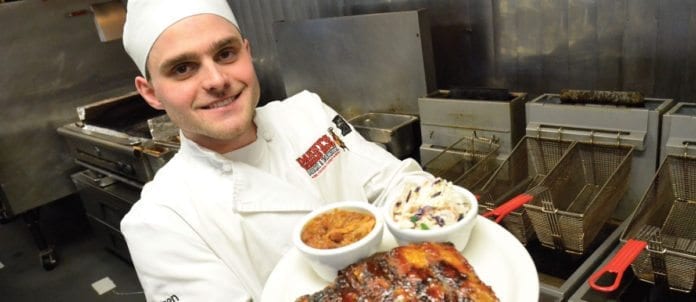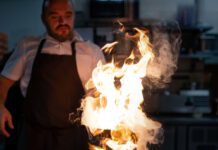There was a time when only a handful of smokehouses populated the urban landscape. Today, as demand grows for hearty delicacies such as pulled pork, beef brisket and slow-cooked ribs, smokers and barbecues are becoming mainstays.
Almost everyone who smokes or barbecues food is extremely passionate about it. David Neinstein, chef and co-owner of Barque Smokehouse in Toronto, has even spent time training in the U.S. and judging BBQ Pit Masters competitions. He respects the nuances between the terms barbecuing and smoking. “Barbecuing is to smoke in the classic South American tradition sense. That is, to use indirect heat,” he says. “What a lot of people call barbecuing is actually grilling. The main difference is you have a direct heat source underneath the grill.”
Neinstein has two smokers — one at his restaurant and another at his commissary location (both in Toronto). At Barque, he has a Southern Pride SPK-500 (500-lb. capacity), a combined wood-burning and gas-fired unit that weighs about a ton and rotates food rotisserie-style throughout the day and overnight. His catering division has an SPK-850 model, which is cheaper but longer and thinner. “I was trained on it,” he says. “It’s one of the smarter smokers available.”
To Neinstein, the most important feature on his smoker is the thermostat that allows him to set a timer and desired temperature, which is maintained within 5°F to 8°F. “I can put food in at night and go home after setting a standard 225°F temperature. Once the wood burns out, the gas-fired burner will continue to heat it. The internal gauge determines if more heat is needed as the wood burns,” he says.
Once cooking is complete, the smoker switches to a 150°F “holding pattern” — just hot enough to keep bacteria from growing but low enough to prevent the meat from continuing to cook, Neinstein explains. This feature is invaluable, because it means there doesn’t need to be someone on site to add wood or monitor the machine for airflow changes.
The smoker is so integral to Barque’s operation that real estate for the restaurant was scouted with the equipment in mind. “We landed on a location that had a double door that opened wide. That was important, because [the product] comes as a big box — about 6x6x6 feet — that can’t be disassembled and reassembled. We were able to roll it in. I’m told others have had to remove a front window or use a crane to get one in,” says the businessman. It was also possible to vent directly onto the roof due to the 20-foot ceilings. “If we had another couple of floors on top we would have had to vent outside, which can be cost-prohibitive. If you were in a building with six storeys or more, it could cost tens of thousands of dollars for the venting alone,” Neinstein says.
Once the unit was installed, Neinstein called an engineer and fire inspectors to ensure it met safety requirements. It needed a straight chimney with a ventilated duct, a hood with enough suction to draw the air to the roof and a built-in fire suppression system (in this case, it’s built into the smoker).
The chef estimates the equipment, delivery, installation and hood mechanism cost $30,000, plus an additional $4,000 to $5,000 for venting. “That’s about what you’d spend on a wood-fired pizza oven from Naples, [Italy],” he notes.
Neinstein has also worked with smaller units, including a Traeger electric wood-pellet unit ($700 to $1,500). “It’s not insulated, so it’s more for general home cooking. Cookshack also makes an electric box model that works off pellets. And, Bradley produces smaller units that can be as small as two-feet tall by one-foot deep, which makes them great for small restaurants,” Neinstein says.
Danny Kleinsasser, owner of Danny’s Whole Hog BBQ & Smokehouse, Buck’s Sports Lounge, catering operations and a commissary in the Winnipeg area, has a combination of stationary and portable units from Southern Pride. He’s always been a big proponent of investing in quality equipment sourced through meticulous research. “You can have the best barbecue sauce and spices in the world, but that has to go hand-in-hand with the right equipment with the right temperature control,” he says.
When researching a new piece of equipment, Kleinsasser considers service and maintenance. “I don’t want to buy something if I can’t get overnight service,” he explains, adding that easy installation is important. “We were given the blueprint, and all we needed to do was get an electrician to install it. It only took a day,” he says.
Of course, smokers also need complementary equipment. Barque has a Winston Industries CVap holding oven ($3,000) to prevent meat from drying out. Other must-haves include a vacuum sealer, immersion blenders, spice grinders and mixers for creating rubs and sauces.
But, smoking isn’t always the favoured choice when it comes to cooking over a flame. For Peter Wright, owner of Guerilla Gourmet Corp., a Mississauga, Ont.-based provider of outdoor event cooking demonstrations, grilling is the way to go, despite the fact his gigantic, specially appointed Extreme BBQ Trailer has a dedicated space for a smoker. “Smokers take far too long when you’re at a festival or event,” he explains.
When selecting a barbecue, he checks the proximity of the grill to the heat source, capacity and construction. “There are commercial grills that have terrific capacity for around $2,500 to $3,500,” he says. “Crown Verity is a good one, and it’s easy to find. It has capacity options, ranging from 30 to 100 inches. Vermont Castings went bankrupt, but you can still find units, because they’re so popular. Broil King also has some great grills. One of my favourites is a two-cover design, so you can cook fish on one and burgers on the other and never the twain shall meet.”
As far as heat sources go, “You can’t beat the speed and control you get with propane or natural gas,” Wright says, adding that he cooks with charcoal when he has time, when he’s producing a gourmet menu or when he’s trying to achieve a certain taste.
Overall, Wright doesn’t look for fancy functions when sourcing a barbecue. “Electronic starters or thermometers are the things that go first. Any professional will have a meat thermometer anyway. The most important thing to look for is a stainless-steel or cast-iron construction or a combination of both. Stainless-steel is great for quickly cooking food like vegetables [that] don’t stick much. For authentic carnivore stuff, I go old-school and use cast iron,” he says.
The better the barbecue, the better the temperature control. “If you go cheap, you will have to replace it more often,” Wright advises. “You’re better served buying something that will throw big amounts of heat, control [temperatures] and stand the test of time.”





















